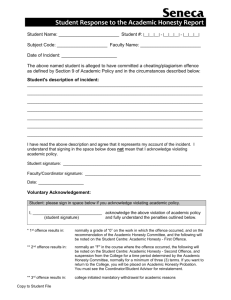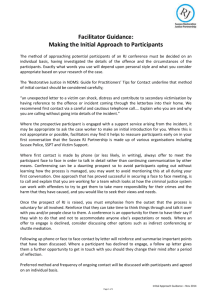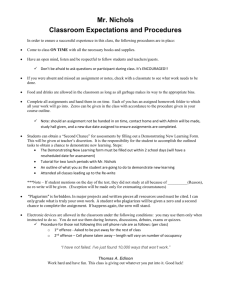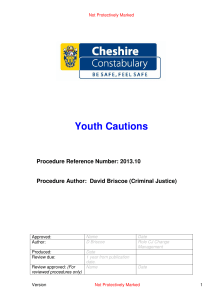Evidence Collection Procedure
advertisement
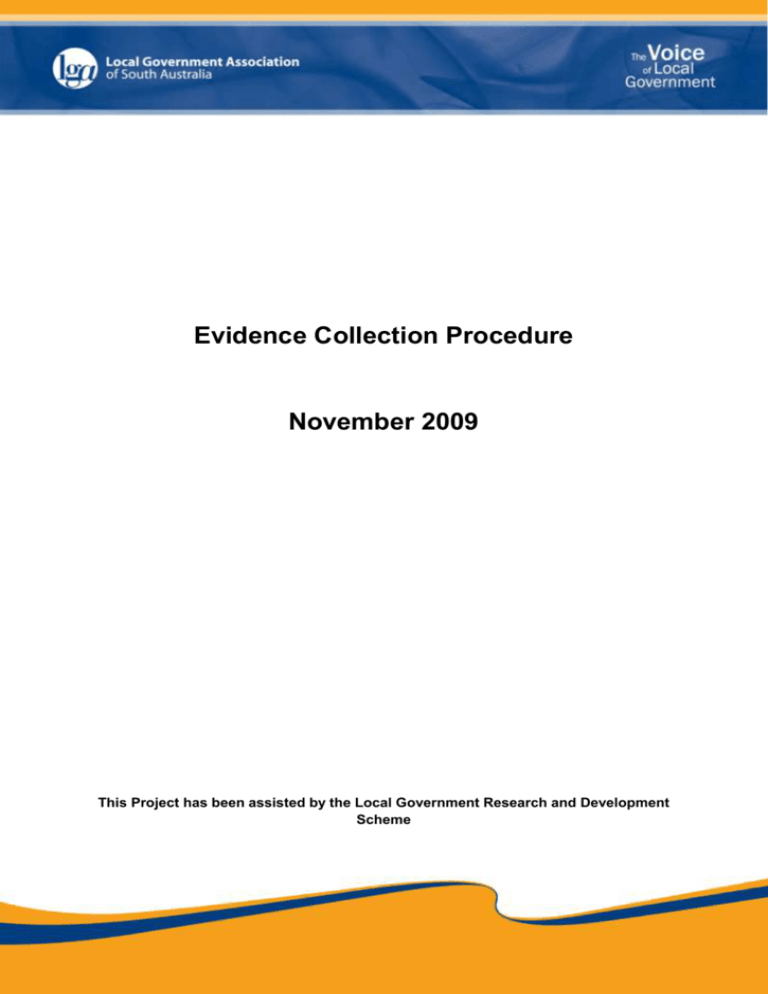
Evidence Collection Procedure November 2009 This Project has been assisted by the Local Government Research and Development Scheme Evidence Collection November 2009 0 1 Purpose and Scope This procedure describes methods of evidence collection in relation to suspected breaches of legislation. The procedure covers evidence gathering from the commencement of an investigation to the enforcement of the legislation and includes how to conduct interviews, statements, taking notes, photographs, sampling and record keeping. 1.1 Responsibility This procedure applies to persons who carry out investigations and compliance activities under relevant legislation. Officers are required to act reasonably and transparently, demonstrate good customer service, undertake their responsibilities in a proficient manner and use their judgement where necessary to ensure an outcome in line with legal requirements and Council’s Enforcement Policy. 1.2 Legislation & Policy Refer to the “Powers of Authorised Officers” under the piece of legislation that governs the compliance action being taken. 1.3 Definitions The definitions contained herein are not exhaustive and officers may need to consider the relevant legislation for further applicable definitions Site Visit - To enter a place for any reasonable and lawful purpose connected with the administration or enforcement of legislation. Inspection – An examination of a premises, vehicle or business for any reasonable and lawful purpose connected with the administration or enforcement of legislation. Caution – Official wording issued by an investigator to inform a person accused of an offence that anything he or she says when taking a statement, may be used in evidence. 1.4 General Notes Wherever practicable, consult with your Supervisor if you intend to issue a caution in the course of an investigation. 2 Relevant Documentation Best Practice Procedures for Appointing Authorised Persons 3 Record Management All documents, notes, photographs and correspondence must be retained and stored in accordance with Council’s Records Management protocols as required by Section 125 of the Local Government Act 1999. Evidence Collection November 2009 1 4 Procedure 4.1 Preparation for an inspection Prior to any visit or inspection carry out any necessary preparatory work which may include: Checking rights of entry to the site Checking past history Arranging appointments or obtaining a warrant of entry (Attachment A) if necessary Collating existing information and preparing questions to be asked Checking equipment to be used and assembling all items required for the tasks ahead. Always ensure you have: o Photo Identification (Authorised Person) o Note book/Pen o Mobile Phone o Camera, spare battery, memory card o Personal protection equipment; e.g. visibility vest, sun hat etc. Note that ‘inspection’ does not mean search – it means using your eyes only. 4.2 Taking Photographs Ensure the photograph captures all the relevant details and is legible. Start with a wide angle shot (shop front, business name, street signs). Filter the following photographs to show close-ups of the specifics you wish to capture in detail. Photographs can be digital or 35 mm. If using a digital camera – the correct time and date must be displayed. When printing from the digital camera – ensure the time and date appear. All photographs must be stored in accordance with Council’s Records Management protocols. 4.3 Note Taking Anything of significance which occurs in the course of an investigation should be noted “at about the time” (not the “exact time”), whilst the facts are still fresh in your memory to provide a permanent on-the-spot record. When giving evidence in Court, your original notes may be required. Notebooks should be bound and pages numbered, however certain situations dictate that notes can be recorded on foolscap paper, plan drawings, field receipts, labels, post-it notes, typewritten, and e-mail. Evidence Collection November 2009 2 Details to take note of: Times and dates when notes are commenced and completed Location (a line map of what happened and where can be useful) Entries should be in ink pen Erasures should be avoided, alterations should be denoted by a single line through the entry and initialled by the writer Entries are kept in sequence Notebook pages are not removed or damaged Notation of any other persons present (interview situation) Spaces and/or lines shall not be left blank Pages that have space left after the completion of taking notes shall have a diagonal line drawn across the page to prevent additional information being added If possible notes should be signed by all present to confirm that they are a true record of the event Store notebooks in a secure location. The notebooks are Council property, and part of the official records of Council. 4.4 Interviews An interview is a conversation to learn the facts of an investigation. It is important to get a first hand, detailed account. In particular: Complainant details (name, address, contact particulars) Alleged offence (has an offence been committed) Alleged offender (who committed the offence) Interview location (dates and times) Incident location details (e.g name of reserve, street address, map location grid reference) Incident occurred (dates and times) Location of complainant/offender when incident occurred Incident details (what happened) Authority notified (dates and times) Certain circumstances may require an ad-hoc interview to take place in the field without prior preparation. Ensure during the interview that you obtain all contact details of those involved for any further questions. 4.4.1 Types of questions to be avoided Leading Questions – questions which prompt or encourage a specific answer, such as “Did you discharged the liquid into the stormwater system?” Multiple Questions – questions that ask for a number of responses such as, “Did you discharge the waste liquid into the stormwater system, and then wash it down with water, then fail to report it to your supervisor?” Evidence Collection November 2009 3 Ambiguous Questions – questions which are unclear such as, “During work hours or after work did you or your work colleague discharge the waste into the stormwater system or gutters?” 4.5 Issuing Cautions If you have not formally cautioned a person whom you suspect has committed an offence, there is a possibility that any statement they give you will not be admissible in court. Therefore, where the nature of the offence under investigation is serious and could result in a Court proceeding, caution those about to be questioned in relation to an alleged offence. Matters to consider in deciding whether the offence could result in a Court proceeding include: the seriousness and effect of the offence the intent of the offender the forseeability of the offence, or the circumstances leading to it the history of offending whether there is enough evidence to prove the offence If a person under investigation for a serious offence makes an incriminating statement before there is time to appreciate the essence of the statement, caution the person immediately upon realising its significance. 4.5.1 How to Caution If there is a reasonable expectation that the person being interviewed has committed the relevant offence and is likely to be prosecuted for it, issue a caution. There are a number of forms of a ‘caution’ and the words below represent a good example: “I am going to ask you some questions in relation to [details of the alleged offence]. You do not have to answer them unless you wish to do so, but anything you say will be taken down and may be used in evidence. Do you understand?” Note: The words ‘against you’ should not be used in a caution as it could stop a person from making a statement or further statement. 4.5.3 When not to caution The person need not be cautioned if questions are put to them for other purposes, for example, to establish their identity, or the ownership of any vehicle or animal. 4.6 Interpreters Some interviews will require the assistance of an interpreter. The interpreter must be briefed on the background information and confidentiality prior to the interview. 4.7 Statements A statement is an individual’s truthful account of an incident they saw, heard, said etc. A statement should be comprehensive, accurate and always use the witnesses’ language. When taking a statement the following rules must be followed: Evidence Collection November 2009 4 Record the facts of the incident which accurately reflect what was seen and heard. Determine the competence of the individual making the statement as this may be later challenged in court. Record the statement by either written or Dictaphone recording. Begin recording with dates and times etc The content of a statement should include: 1. The full name of the person providing and recording the statement. 2. Contact details of the person providing the statement 3. Relevant background information (e.g. occupation) 4. Date, day, time, what took place, who was involved, what was said and who said it 5. Witness signature 5 Monitoring and Review of Procedure This procedure was endorsed by ______________________________to take effect on __________________________ Thereafter it will be reviewed annually. The next date of review is__________ 6 Attachments Attachment A warrant of entry template Best Practice Notes Evidence Collection November 2009 5




